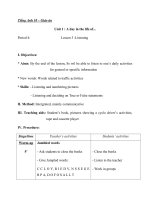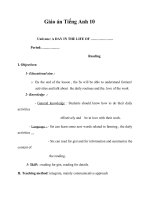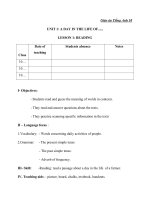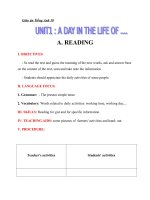LESSON PLAN tieng anh 10 unit 5
Bạn đang xem bản rút gọn của tài liệu. Xem và tải ngay bản đầy đủ của tài liệu tại đây (149.79 KB, 7 trang )
LESSON PLAN
ENGLISH 10- UNIT 5: INVENTIONS
LESSON: READING
I.
II.
III.
IV.
Class details:
Grade: 10
Number of students: 40
Time allotted: 45 minutes
Date: October 19th, 2015
Objectives: By the end of the lesson, Ss will be able to:
Skim for the gist of the text.
Use vocabulary and structures related to the topic Inventions in order to read
and talk about the topic.
Read the passage for main ideas (from textbook).
Guess the meaning of words based on contexts.
Scan for specific information about natural world as inspiration for
inventons.
Material/ visual aids:
Textbook, pictures, white board, handouts.
Procedure:
Stages/Time
I. Warm up
(5 minutes)
Step and activities
Work
arrangement
Game: Word-square
- T divides the class into 2 groups.
- T gives instructions:
+ I will give each group a word-square; it
consists of 9 rows and 9 columns.
+ Each group has 4 minutes to find out 8
worlds in this word-square.
+ If the group who finds out 8 words more
quickly than another group, gives the
word-square for me. They will be the
winner. The winner will received my
small gift
- T checks instructions:
+ What are you going to do?
Expected answer: play word-square game
+ How many verbs do you have to find out?
Expected answer: 8 verbs
+ How many minutes do you have in this
game?
Expected answer: 4 minutes
- T gives each group a word-square.
V
M
A
B
N
C
Q
X
S
A
I
L
E
M
A
I
L
A
I
O
D
I
A
K
L
A
M
E
Q
T
E
Z
O
B
P
K
B
B
P
B
O
A
X
T
H
O
F
H
V
Q
G
H
O
A
O
A
O
E
I
F
A
P
T
K
J
N
X
P
E
L
M
J
-Listen carefully
-Sit into
2 groups
-Listen carefully
and take note the
rule of the game.
-Answer some
questions.
N
S
E
K
O
L
J
D
E
-Play the game
- T starts the game. After 4 minutes.
Teacher shows the answer on the slide
checks the answers and find out the
winner.
V
M
A
B
N
C
Q
X
S
A
I
L
E
M
A
I
L
A
I
O
D
I
A
K
L
A
M
E
Q
T
E
Z
O
B
P
K
B
B
P
B
O
A
X
T
H
O
F
H
V
Q
G
H
O
A
O
A
O
E
I
F
A
P
T
K
J
N
X
P
E
L
M
J
N
S
E
K
O
L
J
D
E
- Lead in: Can you guess what we are going
to learn today?(calls a student to answer)
Today, we will study Unit5: Inventions
- T writes on top of the board.
II. Prereading
(13 minutes)
1. Teaching vocabulary:
• Invention [in'ven∫n] (n): sự phát minh
Eliciting technique: translation
(T asks, 'How do you say "sự phát minh" in
English?'.)
• Imitate ['imiteit] (v): bắt chước, mô
phỏng theo
Eliciting technique: explanation
(T explains,"I behave in a similar way to
someone or something else, or to copy the
speech or behavious"
T- whole class
- Ss guess the
new words.
- Listen and
repeat.
- Ss copy down
on their
T asks," What am I? Tell me word in
Vietnamese".)
notebooks.
• Laptop ['læptɔp] (n): máy tính xách
tay
Eliciting technique: visuals
(T says: “Look at the picture. What is this?”)
• Inspiration [,inspə'rei∫n] (n): nguồn
cảm hứng
Eliciting technique: synonym
(T asks, "What's another word for
creativeness?)
• Principle ['prinsəpl] (n): nguyên tắc
Eliciting technique:
(T asks, Who can tell me the word “nguyên
tắc” in English?)
Steps for Presenting Vocabulary:
+ T elicits the new words.
+ T model two or three times.
+ Ss repeat in chorus.
+ Ss repeat individually.
+ T corrects.
+ T write the word on board, Ss copy
+ T check stress/ intonation.
+ T help Ss practise/ memorise.
2. Checking vocabulary:
Rub out and rewrite.
-T asks Ss to close their notebooks.
-T rubs out the new words one at a time.
- After rubbing out a word in English, T points
to the Vietnamese meaning and asks : “What’s
-Ss close the
notebook.
this in English ?”
- When all the Ss words are rubbed out, T goes
through the Vietnamese list and get Ss to call
the English words.
- T asks some Ss to go to the board and rewrite
the rubbed words in order to check spelling.
- T gives feedbacks.
III. While
reading
(15 minutes)
1. Reading:
• T gives intructions
-T asks Ss to open the book, read the text in 4
minutes.
- T asks Ss work in individual.
-T asks Ss to choose the most suitable of the
text and writes them on the board.
-T corrects and gives keys.
• T checks intruction:
- How many minutes do you have?
=> 4 minutes.
Questions: What is the most suitable title of
the text?
a. Mother Nature
b. Imitating Nature
c. Greatest Inventions
- Remember the
Englih and
Vietnamese
words.
T – whole class
- Ss listen T’s
introduction.
Key: b. Imitating Nature.
2. Matching:
• T gives intructions:
- T asks Ss matching the Words with their
mearning in 3 minutes.
- T asks Ss work in individual.
- T asks Ss go to the board to match.
T-whole class
• T checks intruction:
- Can you work in pairs or individual?
=> Individual.
Matching:
1.inspire
a. cloth or material for making
clothing, curtains, etc.
Work in pairs
2. fastener
b. give someone a desire to do
something well.
3. fabric
c. thread or fibre with a curved
end.
4. hook
d. special clothing for an
astronaut.
5. loop
e. device used to close a piece
of clothing.
6. spacesuit
f. thin thread or fibre in the
shape of a circle.
Keys: 1-b 2-e 3-a 4-c 5-f 6-d
3. Question and answer:
• T gives intructions:
- T asks Ss work in pairs.
- T asks Ss read the passage again and prepare
for answers in task 4 (p. 51) in 5 minutes.
- T call some Ss answer and wirte correct
answer on the board.
- Ss have a correct answer will have a good
marks.
• T checks intruction:
- How many minutes do you have?
=>3 minutes.
- How many marks if you have a correct
answer ?
=> 1 marks.
Questions:
1. What are the inventions that imitate
animals?
2. What are the inventions that imitate plants?
3. Why is the aeroplane considered one of the
greatest inventions in our history?
4. What can help scientists to learn about life
under the sea?
5. How can a glass window clean itsealf?
6. Find the words or phrases in the text that
can describe an aeroplane, a submarine, and
Velcro.
Keys:
1. The inventions that imitate animals are the
aeroplane and submarine.
2. The inventions that imitate plants are
Verlco, the self- cleaning glass window and
umbrella fablric.
3. The aeroplane is considered one of the
greatest inventions in our history because it
helps us to travel long distances in the air and
encourages the development of tourism and
trading.
4. A submarine can help scientists to learn
about life under the sea.
5. The material that makes up the glass
window has the ability to wash away the dirt in
the rain.
6. An aeroplane: 'its wings and shape' The
Velcro: 'hook-and-loop fastener'; 'two fabrics
sticking together thanks to the hooks on one
surface and the loops on the other'
IV. Post
reading
(10 minutes)
V. Home
work
(2 minutes)
Discussion:
• T gives instructions:
+ T asks students to work in pairs and discuss
about the question: “Which of the four
inventions mentioned in the text is the best
imitation of nature? State your reasons.”
+ Ss share your ideas with your friend.
+ Ss have 5 minutes.
+ T call some students answer.
T checks instruction:
+ What is your duty?=> discuss about
question.
+ How many minutes do you have?
=> 5 minutes.
- T goes around to observe and provide help.
- T gives feedback.
- Teacher asks Ss to learn all of the new words
and prepare SPEAKING for the next period.
Work in pairs
- Ss listen and
copy down.
- T–whole class.









